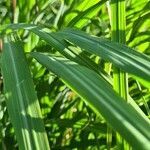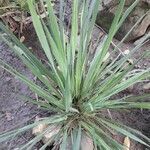Perennial from a stout rootstock. Culms tufted, robust, up to 2.5 m tall, 1–2 cm in diam. Leaf sheaths reddish purple at base, smooth, glabrous; leaf blades dark green or dark brown when dry, drooping for 1/3 of their length, 30–100 × 1–2 cm, glabrous, abaxial surface scabrid, adaxial surface smooth, base narrow, apex long acuminate; ligule 2–3 mm. Spathate panicle large, narrow, congested, interrupted, 60–90 cm; spatheoles reddish brown, 1.2–2.5 cm; racemes 1–1.5 cm; rachis internodes and pedicels ciliate on margins; pedicel of homogamous pair not swollen. Sessile spikelet oblong-lanceolate, 3–4.5 × 1–1.2 mm; lower glume flat or slightly concave, reddish brown or purplish upward, sharply 2-keeled, keels narrowly winged, obscurely 0–3-veined between keels; upper lemma linear, entire or slightly 2-lobed, mucronate or very shortly awned. Pedicelled spikelet 3.5–7 mm. Fl. and fr. Nov–Apr. 2n = 40.
Robust tufted perennial 1 200-2 400 mm high; leaves mainly basal. Leaf blade 200-700 x 4-10 mm, apex thread-like, margins scabrid; ligule an unfringed membrane, (2.5-)3.5-7.5 mm long, erose. Inflorescence dense, usually reddish; raceme lowermost internode and pedicel filiform, not fused together; internodes and pedicels hairy along margins, back glabrous. Sessile spikelet 3.8-6.5 mm long; lower glume shallowly grooved or flat, upper narrowly to broadly winged (may occur together on same inflorescence), nerveless or 3-nerved; upper lemma bifid, awn 6.5-11.0 mm long; anthers 1.2-3.0 mm long. Pedicellate spikelet 4.0-5.5 mm long, awnless.
Robust perennial, tufted, up to 2.4 m high. Leaf blades 500-700 mm long, 5-10 mm wide. Spikelets (sessile) 4.5-6.0 mm long (pedicellate slightly shorter). Racemes nearly glabrous; lower glume of sessile spikelets winged, flattish.
A grass. It is a perennial herb. It grows 0.8-1.5 m tall. It forms tufts. The leaves are 30-100 cm long by 1-2 cm wide. The flowering shoot is 30 cm long and branched.
Like C. prolixus but culms robust, 1.2-2.4 m tall and leaves broader, 5-10 mm wide.


